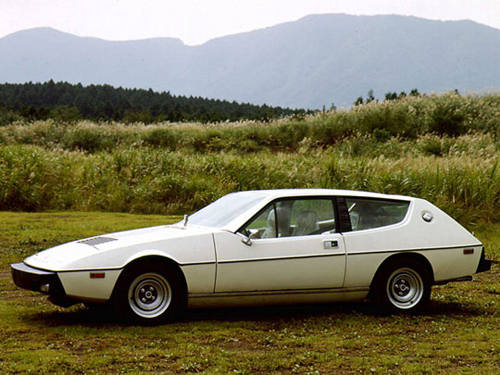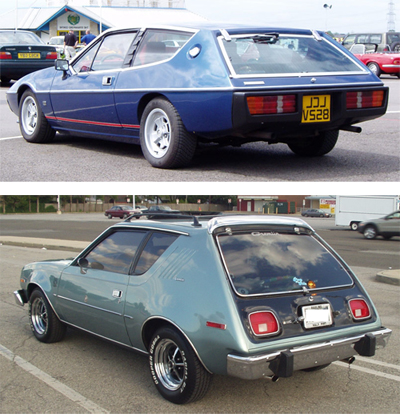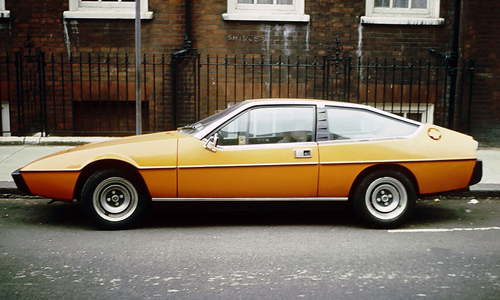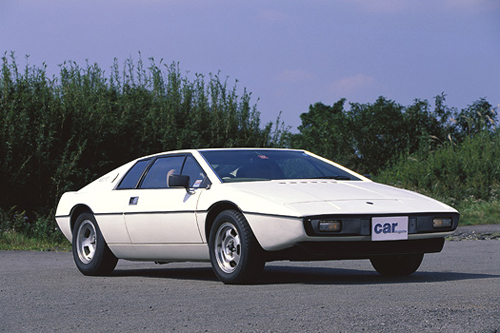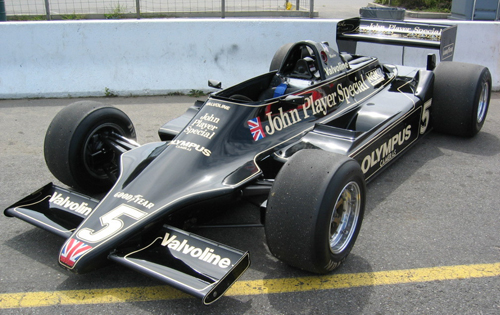
|
Lotus is one of the most improbable car companies that has ever been. It was founded in the early '50s by one individual, a man named Colin Chapman, who adopted a philosophy of performance through low weight and simplicity. The initials of his full name Anthony Colin Bruce Chapman adorn the logo. Chapman did not initially set out to build an automobile manufacturing empire. He actually got his start as an industrious 20 year old who created one-off race cars based on existing platforms and components. His cars began to out-class the compentition, and it wasn't long before people started to request that he build and sell them copies. When demand got to a certain point, Chapman quit his day job and formed Lotus Engineering Ltd. He started mass producing race cars that were sold to race teams and drivers as kits. The Lotus company designed and built the chassis and bodies, and fitted them with commercially available components. Generally the customer would install whatever engine and drivetrain suited their needs and/or conformed their formula of racing. To look at these cars today you would think they were quaint, old-fashioned buggies, but in fact there were technologically advanced, ultra light-weight packages with cutting edge road holding characteristics. Lotus developed a reputation early on for superior handling, and it has stuck with them to the present day. One of these early production race cars, known as the Lotus Seven, was actually street legal, and people started registering them and driving them recreationally as sports cars. While Chapman never set out to make production cars, this unexpected happenstance produced an additional stream of revenue to fund his racing ventures. Production increased to meet consumer demand, and the Seven actually stayed in production for more than a decade. When Lotus was done with it they licensed the rights to a third party company called Caterham who continues to produce it as a kit car to this day. 
The Lotus Seven, their first street-legal car Lotus continued making limited production race cars, but with the commercial success of the Seven they eventually set out to design and manufacture a car that was purpose built for the road. It was called the Elite, and it made its debut at the 1957 London Car Show. They were cute, aerodynamic little coupes with fiberglass monocoque bodies with fully independent suspension and four wheel disk brakes. Although it was built for the road, it quickly found its way to the track, were it enjoyed great success. 
The Elite was their first, purpose-built street car The Elite was soon followed by the Elan, a similarly styled 2-seater that came in fixed-head and ultimately roadster versions. Like the Elite it had a fiberglass body, but unlike the Elite it was not a monocoque. It used an unconventional steel box backbone chassis, where the front and rear suspension tee'd off from a single, central spine. It was simple and light-weight. It was a design component that would be used on many future models. 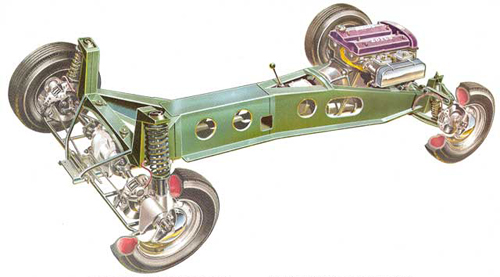
The steel backbone chassis Stylistically the Elan was a pretty conventional British sports car, but the roadster had the unusual characteristic of rigid window frames that remained in place even when the top was down. It may have been effective from a weather-proofing standpoint, but visually it detracted greatly from the clean, open look of a drop-head sports car.
Perhaps the Elan's greatest claim to fame was it's prominent use by Emma Peele in the cult classic BBC program "The Avengers." 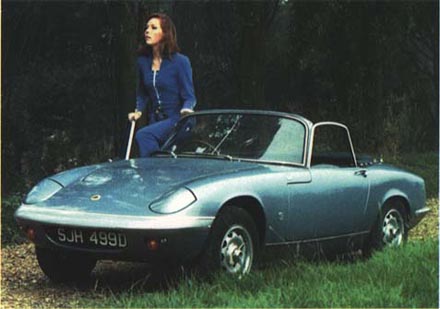
Emma Peele went everywhere in her Lotus Elan Back on the race track, Collin Chapman continued to innovate. By this time he was involved in Formula 1 racing, and the revolution he was leading was the mid-engined configuration. It wasn't a Lotus invention, but they were the first to be seriously successful with it. Despite the demonstrable advantages, other teams were slow to adopt it. Ferrari in particular clung on to the front-engine format until it simply became undeniable that it was an inferior design. Eventually Lotus employed the mid-engined layout on a street car. To expedite the development process, they leveraged an engine/drivetrain setup from Renault. The French had long been using the "ass backwards" configuration on their front wheel drive cars. The engine was mounted longitudinally under the hood, but with the transmission out in front and half shafts sticking out to drive the front wheels. Lotus took the engine and transmission out of a Renault R16, spun it around, slipped it into a steel backbone chassis that had been modified to mount the engine aft of the passenger compartment, and voilá, they had a mid-engined platform. This prototype became the Lotus Europa. In terms of engineering it was cutting edge. In terms of styling it left much to be desired. The front half of the car borrowed much from the Elite and Elan. It was conventionally British with its sloped nose and bug-eye headlights. But the back end of the car was an uninspired, utilitarian fiberglass box. It looked a little like a shrunken El Camino. It was Lotus's first attempt at styling a mid-engined car, and it didn't seem that the designers put much thought into it. But it did establish Lotus's "devil may care" attitude towards styling, and it didn't detract from the car's success. It started a new era for Lotus street cars.
Lotus's accessible mid-engined sports car, the Europa The Europa remained in production for almost 10 years, but as it's lifecycle was winding down, new things were in the works at Lotus. They had plans to introduce a new line of cars to keep pace with stylistic and technological developments in the automotive world. In terms of power, they had been working on a 2 liter, DOHC, 16-valve, 4 cylinder engine. For a time the plan was to create a 4 liter V8, but the realities of the energy crisis, and other limiting factors, caused them to scale it back. Known as the 907, the engine first went into the Jensen Healey. Regrettably there were a lot of issues with it, which was bad for Jensen Healey, but good for Lotus in that all the bugs were worked out by the time it went into one of their products. The first new model to make it out of the Lotus factory was a 2+2 GT they chose to call the Elite II. It really bore no resemblance to the original Elite, being considerably larger and designed for 4 passengers. Stylistically it was also a big departure for Lotus. Gone were the swoopy, curved lines of their other offerings. The Elite II embraced the "wedge" aesthetic, with a sloped nose, raked windshield, and lots of flat surfaces and sharp edges. They did, however, persist with the fiberglass body over a steel backbone chassis.
The Elite II: The shape of things to come for Lotus Stylistically, Lotus were on the right track. but they didn't exactly hit a home run with the Elite II. Not unlike the Europa, the sleek and stylish front end was matched to a rather awkward and inelegant rear end. The large, obstructive, pyramidal c-pillar and abrupt, monolythic hatch of the Elite II was reminiscent of the AMC Gremlin. Each looked a little like the designers ran out of ideas and sheared the rear end off with one simple stroke.
Twins: Arnold Schwarzenegger and Danny Devito However, Lotus had more to come. The following year they released a fastback version, known as the Eclat, which addressed some of these issues. For the most part it was identical to the Elite II, but the rear end was more gracefully styled. It was more successful visually, with concordant lines, open and airly visibility, and better use of space. It represented a maturity and refinement in Lotus' styling, but it was nothing compared to what was about to come.
The fastback Eclat was more balance stylistically The same year tha the Eclat was released, Lotus unveiled the Esprit at the Paris Auto Show, and it went into production the following year. It had been in development concurrently, but the Elite/Eclat beat it to the road. It was their mid-engined, 2-seater replacement for the Europa. Like the Elite/Eclat it was styled with the angular, wedge-look of the day, but the Esprit was a striking beauty without exception. The proportions, the lines, the angles, everything was spot on. It's looks were timeless, holding up very well to todays styling, and remains to this day arguably the most perfectly styled mid-engine GT ever produced.
The timeless Lotus Esprit Under the skin the car was nothing remarkable. It employed the same steel backbone chassis concept that had now become commonplace at Lotus. It shared the same 907 engine that had been put into production with the Elite/Eclat. And taking a note from the original Europa, they took a gearbox out of an ass-backwards front wheel drive French car (in this case the Citroën SM), and turned it around for a mid-engined configuration. But, as had become the norm at Lotus, commonplace by their standards was exceptional to the rest of the world. It did have a reputation for being somewhat underpowered, but it was a true exotic, with looks to kill and handling to match, for about the price of a fully-loaded Corvette. As if the car weren't already destined for greatness, it was immortalized in the James Bond thriller "The Spy Who Loved Me." The movie came out just as the car was being released, and it solidified the Esprit's place in automotive and movie history. It may have been one of the most implausible automotive transformations in any of the Bond films, but it was equally as memorable.
One of the most famous Bond cars in franchise history The Esprit was immensely successful, and became Lotus' flagship. It remained in production for almost 30 years, undergoing many revisions and enhancements along the way, with a major restyling about ten years in. Read my comparative styling analysis for more details. See also the comprehensive list of Esprit sub-models at the Lotus Esprit World site. In 1978, as the Esprit was enjoying great success, Lotus dominated Formula 1 racing. Chapman had again been making great innovations. In this case it was the "ground effect" design. F1 cars had long been employing wings to generate downforce and give the cars better stability and handling, but Chapman came up with the idea of basically turning the whole body into an upside-down wing that would generate considerably more downforce. In 1977 Lotus was having a miserable year. Driver Mario Andreti wanted to introduce the new car, which he knew to be wholly superior, but Chapman wouldn't let him. He didn't want to let the cat out of the bag and allow other manufacturers to experiment with the concept in the off season. He sat on the design, and swore Andreti and the rest of the team to secrecy. They unveiled the new car for the start of the 1978 season, and they kicked ass all season long, taking the constructors' championship.
Lotus' ultimate Formula 1 car Alas, this would be the last great hurray for Lotus in F1. They hung on for a few more seasons, but the nature of the sport was changing, and a little outfit like Lotus couldn't keep up. Then, in 1982, Colin Chapman died unexpectedly of a heart attack. Lotus had now become a corporate entity unto itself and was well situated to continue without him, but Chapman had been a driving force, and in many ways the company would need to find a new identity as it soldiered on without him. In 1983 Lotus dropped the Elite II model, and replaced the Eclat with an updated version called the Excel. Lotus had begun a collaboration with Toyota, and used many parts from the Supra Mk II in the Excel. The Excel remained in production for 10 years, but none ever made their way to the US. In 1986, Lotus was purchased by General Motors. The little upstart car company was now part of the largest automotive conglomerate on the planet. More to come...
Cars Index | Next Essay: Formula 1 |


